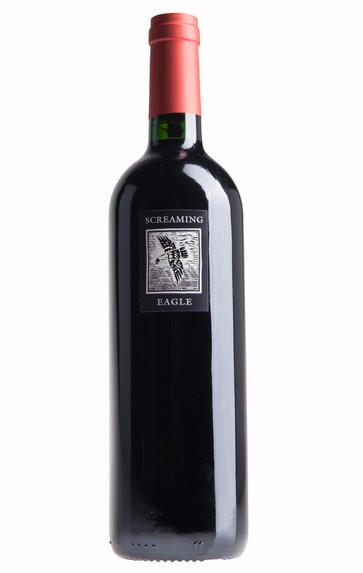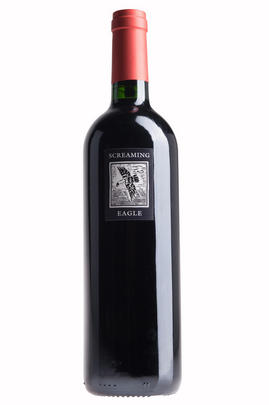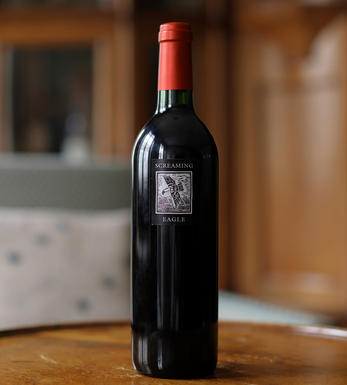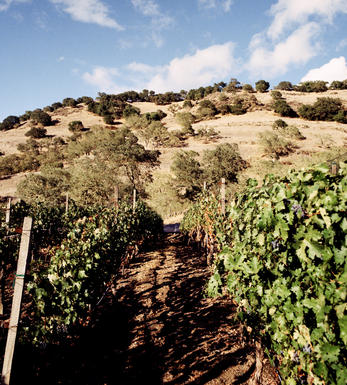
2011 Screaming Eagle, Cabernet Sauvignon, Oakville, Napa Valley, California, USA

Critics reviews
Robert M. Parker, Jr. - 31/10/2013
About this WINE

Screaming Eagle
Screaming Eagle is one of the original Californian "cult wines". Proprietor Jean Philips never dreamt that her wine would be so sought after, when in 1992, after years of selling grapes to Napa Valley wineries, she decided to find out if her home-made wine, created in a plastic trash can, was any good. She took a sample down to Robert Mondavi where they thought enough of her dark, rich, cassis-flavoured Cabernet to encourage her to bottle it, though they snickered at her proposed name. The rest is history.
Screaming Eagle's 100% Cabernet Sauvignon vineyard is ideally situated. The soil is virtually a rock pile on a gentle, west-facing slope east of the Napa River. Drainage and exposure are excellent. The property is at a point in the valley where the weather is hot enough during the day to ripen Cabernet to its optimum, yet the grapes are cooled by the afternoon breezes that blow north from San Pablo Bay.
Only 500 cases a year of Screaming Eagle are produced under the direction of winemaker Heidi Peterson Barret. The resulting wines are brimming with deep, plush layers of flavour, echoing currant, cassis, blackberries and black cherry. The tannins are soft, round and polished, yet firm enough to give every indication that Screaming Eagle wines will age beautifully for 10 to 20 years.

Napa Valley
North Coast's Napa Valley is California's most famous viticultural area (AVA), claiming some of the most expensive agricultural land in the world and producing wines of ‘cult’ status.
Its 16,000 ha of vines lie over a strip (40 miles long-5 miles wide) of diverse soils (clay, gravely, volcanic), with its northernmost end on the side of Mountain Helena and its foot in San Francisco Bay. The valley is framed by two mountains ranges Vaca (to the north) and Mayacamas (to the south), yet the main climatic influence is the cool wind and fog that is sucked in from San Pablo Bay during the afternoon, allowing grapes to ripen slowly and evenly.
The area enjoys a variety of unique microclimates, as temperatures can vary dramatically as much as 15 degrees, from the north to the south end of the valley. These differences have led to the creation of several sub-AVAs (14 in total) including:
Atlas Peak, Chiles Valley District, Diamond Mountain District, Howell Mountain, Los Carneros, Mt. Veeder, Oakville, Rutherford, St. Helena, Spring Mountain District, Stags Leap District, Yountville, Wild Horse Valley and Oak Knoll District. The Calistoga AVA is still pending approval.
Both the “Napa Valley” designation and the sub-AVA name must appear on the wine label simultaneously, with the exception of wines from the Carneros AVA, which is shared between the Napa Valley and the Sonoma County.
Cabernet Sauvignon is the undisputed king of Napa grapes, occupying over 45% of the vineyard acreage, followed by (predominantly) Chardonnay, Sauvignon Blanc, Chenin Blanc, Riesling, Zinfandel, Merlot, Cab. Franc and to a lesser extent Petite Sirah, Sangiovese, Barbera, Dolcetto.
Recommended Producers
Frog's Leap, Dominus, David Ramey, Viader, Stag's Leap Cellars, Paras Vineyards, Heitz.

Cabernet Sauvignon Blend
Cabernet Sauvignon lends itself particularly well in blends with Merlot. This is actually the archetypal Bordeaux blend, though in different proportions in the sub-regions and sometimes topped up with Cabernet Franc, Malbec, and Petit Verdot.
In the Médoc and Graves the percentage of Cabernet Sauvignon in the blend can range from 95% (Mouton-Rothschild) to as low as 40%. It is particularly suited to the dry, warm, free- draining, gravel-rich soils and is responsible for the redolent cassis characteristics as well as the depth of colour, tannic structure and pronounced acidity of Médoc wines. However 100% Cabernet Sauvignon wines can be slightly hollow-tasting in the middle palate and Merlot with its generous, fleshy fruit flavours acts as a perfect foil by filling in this cavity.
In St-Emilion and Pomerol, the blends are Merlot dominated as Cabernet Sauvignon can struggle to ripen there - when it is included, it adds structure and body to the wine. Sassicaia is the most famous Bordeaux blend in Italy and has spawned many imitations, whereby the blend is now firmly established in the New World and particularly in California and Australia.


Buying options
Add to wishlist
Description
Made from a blend of 75% Cabernet Sauvignon and the rest equal parts Merlot and Cabernet Franc, the 2011 Screaming Eagle Cabernet Sauvignon is a sexy, upfront, precociously styled wine exhibiting a dense ruby/purple color as well as lots of licorice, camphor, black currant jam, new oak and spice box characteristics. Dense, rich and impressive, the early drinking charm of the 2011 vintage gives it immediate appeal. It should keep for 10-15 years.
Robert M. Parker, Jr. - 31/10/2013
wine at a glance
Delivery and quality guarantee